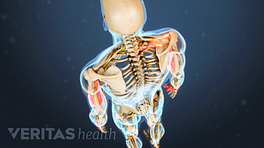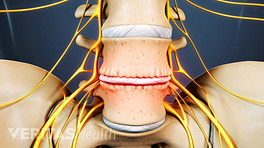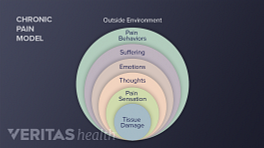It is critical for both the doctor and patient to have an understanding of the difference between acute pain and chronic pain.
Watch Video: Understanding Different Types of Back Pain
With acute pain, the pain is a symptom of injured or diseased tissue, and the severity of acute pain matches the level of tissue damage. When the injury has finished healing, the correlating pain subsides. For example, with a herniated disc, once the pressure on the nerve is alleviated, the acute pain stops. For this reason, medical treatment for acute pain focuses on healing the underlying cause of the pain.
Chronic pain, however, does not serve a protective or other biological function (again, this is referring primarily to the chronic benign pain subtype).
In This Article:
- Chronic Pain As a Disease: Why Does It Still Hurt?
- Types of Back Pain: Acute Pain, Chronic Pain, and Neuropathic Pain
- When Acute Pain Becomes Chronic Pain
- Understanding Chronic Pain
How Chronic Pain Develops
Unlike acute pain, which follows a straightforward path of cause and effect, the course of chronic pain varies widely.
Not all pain that persists will turn into chronic pain, and there is significant variation even among people with similar conditions. A condition that appears relatively minor can lead to severe chronic pain, and a serious condition can be barely painful at all.
The effectiveness of a particular treatment for chronic pain will often differ from person to person. For example, a specific medication or injection for a herniated disc may provide effective pain relief for some people but not for others.
See Non-Surgical Treatment for a Lumbar Herniated Disc
As pain moves from the acute phase to the chronic stage, factors unrelated to tissue damage and injury become more important. Ongoing pain signals despite lack of tissue damage are just part of the equation. Anxiety, depression, and declines in physical condition due to lack of exercise can all have an influence.
Pain Management for Chronic Pain
Spinal cord stimulation is a pain management option for treating chronic back pain.
As chronic pain has become recognized as a primary problem, rather than always being a symptom of a disease, the medical specialty of pain management has grown.
Pain management physicians treat all kinds of pain. Pain management for chronic pain is often done by a multidisciplinary team so that all aspects of pain can be treated at the same time. This follows the previous model, including tissue damage (if present), thoughts and emotions, pain sensation, suffering and the environment. This treatment approach generally includes physicians who have a background in physiatry or anesthesiology, and psychologists who have training in clinical health psychology. Specifically:
- Physiatrists treat conditions that affect movement, focusing on the muscles, nerves, and bones. Physiatrists are sometimes called physical medicine and rehabilitation physicians. Approaches are individualized, and designed to include both the physical and emotional aspects of pain control.
- Anesthesiologists perform a number of interventional and minimally invasive procedures to relieve chronic pain, such as spinal cord and peripheral nerve stimulation and injections guided by x-rays to relieve pain.
Clinical health psychologists who specialize in pain management usually work closely with the treating physician. The psychologist focuses on the thoughts, emotions, suffering, and environmental issues.











